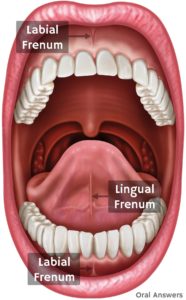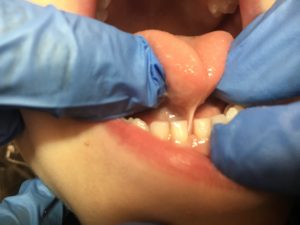 The tongue and lips are attached to the gingiva by a muscular attachment called a frenum. There are two frena (the plural form of frenum) in the mouth. 1. Lingual frenum, which connects the tongue to the floor of the mouth, and the 2. maxillary labial frenum, which connects the inside of your upper lip to your gums just above the upper two front teeth. These frena can sometimes prevent normal function or create pain. Surgical removal of the frenum is called a frenectomy. Today, laser dentistry offer a more comfortable treatment alternative to use of surgical scalpel (blade) with minimal local anesthesia and bleeding, and without the need for sutures (stitches).
The tongue and lips are attached to the gingiva by a muscular attachment called a frenum. There are two frena (the plural form of frenum) in the mouth. 1. Lingual frenum, which connects the tongue to the floor of the mouth, and the 2. maxillary labial frenum, which connects the inside of your upper lip to your gums just above the upper two front teeth. These frena can sometimes prevent normal function or create pain. Surgical removal of the frenum is called a frenectomy. Today, laser dentistry offer a more comfortable treatment alternative to use of surgical scalpel (blade) with minimal local anesthesia and bleeding, and without the need for sutures (stitches).
 Sometimes, the lingual frenum can cause a condition called ankyloglossia or “tongue-tie” which occurs when the attachment runs all the way to the tip of the tongue causing restrictive protrusion of the tongue. Children are able to accommodate well to a restrictive lingual frenum and can eat and speak normally. If the attachment causes abnormal function such as speech impairment, breastfeeding problem in infants (poor latch) then a lingual frenectomy may be necessary to give the child normal tongue function and feeding.
Sometimes, the lingual frenum can cause a condition called ankyloglossia or “tongue-tie” which occurs when the attachment runs all the way to the tip of the tongue causing restrictive protrusion of the tongue. Children are able to accommodate well to a restrictive lingual frenum and can eat and speak normally. If the attachment causes abnormal function such as speech impairment, breastfeeding problem in infants (poor latch) then a lingual frenectomy may be necessary to give the child normal tongue function and feeding.
A prominent maxillary labial frenum can cause a large gap (diastema) to occur between the upper two front teeth. Immediate treatment is not necessary unless the frenum is causing pain on the upper lips and gums or poor oral hygiene. Despite parental concern for the gap, treatment should be delayed until the upper permanent teeth have come in. Many times, the replacement of the baby teeth with permanent teeth will naturally close the gap between the two front teeth. If the gap doesn’t close, then orthodontic treatment (braces) will be needed. During orthodontic treatment, if after closing the gap, the teeth begin to drift apart again and the frenum is deemed to be the cause, then a maxillary labial frenectomy is recommended. A maxillary labial frenectomy should only be attempted after the gap is closed. The frenectomy may cause scar tissue formation between the teeth which makes it impossible to close the gap. Thus, maxillary labial frenectomy should only be performed after it has been shown that the frenum is the causative factor in maintaining the gap between the maxillary central incisors. This determination can occur after the permanent canines erupt (come in). Therefore, a maxillary labial frenectomy is indicated after the age of 11 or 12.